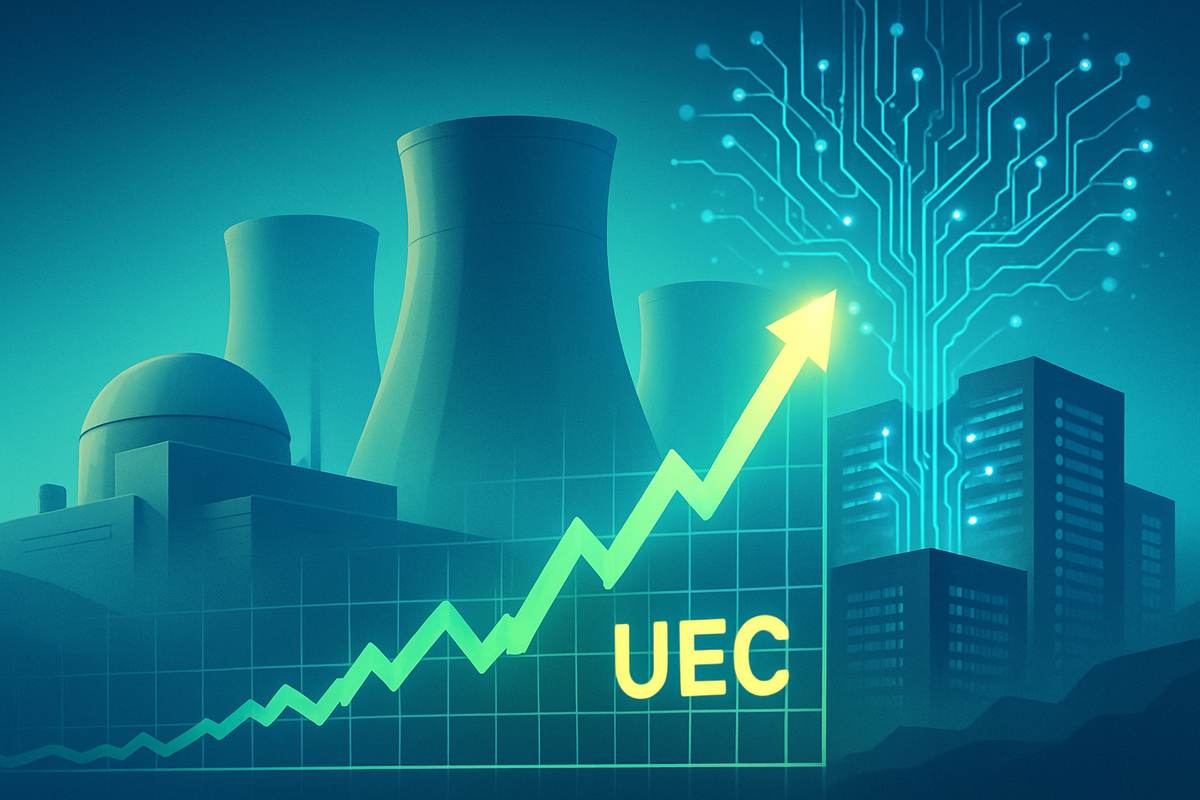Financial News
Uranium Energy Corp Soars to Historic Highs Amidst Nuclear Renaissance and AI's Insatiable Energy Hunger

Uranium Energy Corp (NYSEAMERICAN: UEC), America's largest and fastest-growing uranium supplier, has reached an unprecedented all-time high in its stock valuation, a testament to the surging global demand for nuclear power and the unexpected, yet profound, energy requirements of the artificial intelligence (AI) revolution. The company's shares touched $15.09 USD on October 10, 2025, marking a significant milestone in its trajectory and signaling a robust future for the nuclear fuel market. This remarkable ascent reflects a broader shift in global energy strategies, as nations and industries increasingly turn to nuclear energy for reliable, carbon-free baseload power.
The extraordinary demand for stable and clean energy sources, fueled by both ambitious climate goals and the exponential growth of energy-intensive AI data centers, has created a powerful tailwind for the uranium sector. UEC, strategically positioned with its domestic In-Situ Recovery (ISR) mining operations and plans for a new American uranium refining and conversion facility, stands at the forefront of this energy paradigm shift. Its recent financial maneuvers and operational expansions underscore a confident outlook for sustained growth, as the world grapples with the dual challenges of decarbonization and unprecedented electricity consumption.
Detailed Coverage of the Event
The journey to Uranium Energy Corp's (NYSEAMERICAN: UEC) all-time high of $15.09 USD on October 10, 2025, has been characterized by aggressive strategic moves and a favorable market environment. This recent peak follows a steady upward trend, with the stock previously touching $15.06 USD on September 23, 2025. Over the past year, UEC has seen an astonishing 118.12% surge, and an even more impressive 217% over the last six months. Looking back five years, the company's returns stand at an exceptional 1,256.12%, showcasing a sustained period of growth.
A pivotal event leading up to this moment was a successful public offering in early October 2025, which injected approximately $203.8 million into the company's coffers through the sale of 15.5 million shares at $13.15 per share. The underwriters further bolstered this capital raise by exercising an over-allotment option, securing an additional $30.57 million. This substantial capital infusion is earmarked to accelerate the development of a new American uranium refining and conversion facility, a critical component of the domestic nuclear fuel cycle, managed by UEC's subsidiary, United States Uranium Refining & Conversion Corp (UR&C).
UEC's financial health remains robust, reporting no debt and a strong current ratio of 8.85 as of October 10, 2025. The company's fiscal 2025 revenues climbed sharply to $66.84 million, partly due to a strategic decision to withhold sales in the latter half of the fiscal year to capitalize on anticipated rising uranium prices. This foresight proved accurate, with UEC's recent sales averaging over $82.50 per pound, and current spot prices for uranium oxide (U3O8) surpassing $82 per pound. Key players involved include UEC's management team, who have strategically positioned the company, as well as institutional investors and the broader market that has reacted positively to the nuclear renaissance narrative. Analysts have largely maintained positive outlooks, with price targets ranging from $10.50 to $19.75, reflecting strong confidence in the company's future.
Companies That Might Win or Lose from the Event
The surging demand for uranium, propelled by the global nuclear renaissance and the insatiable energy appetite of artificial intelligence, is creating a distinct landscape of winners and losers across the financial markets. This paradigm shift is particularly impactful for uranium miners, nuclear power operators, and increasingly, major technology companies.
The Winners:
Uranium mining companies are at the forefront of this boom. Cameco Corporation (NYSE: CCJ), one of the world's largest publicly traded uranium companies, is exceptionally well-positioned due to its high-grade reserves in Canada's Athabasca Basin and significant investments across the nuclear fuel cycle. Its long-term contracts offer revenue stability, and the company is poised to expand production to meet rising demand. Similarly, Kazatomprom, the state-owned Kazakh company and the world's largest uranium producer, is seeing boosted revenues, though it faces operational challenges that could further tighten global supply. Other notable uranium miners set to benefit include NexGen Energy (NYSEAMERICAN: NXE), Denison Mines (NYSEAMERICAN: DNN), Energy Fuels Inc. (NYSEAMERICAN: UUUU), and Centrus Energy Corp. (NYSEAMERICAN: LEU), all of whom are advancing projects or involved in the nuclear fuel cycle. Even diversified miners like BHP (ASX: BHP), with its Olympic Dam mine, stand to gain from the increased value of their uranium assets.
Nuclear power operators are also clear beneficiaries, providing the stable, carbon-free baseload power essential for modern economies and AI infrastructure. Constellation Energy (NASDAQ: CEG), the largest operator of nuclear reactors in the U.S., is a prime example, securing high-profile, long-term power purchase agreements (PPAs) with tech giants like Microsoft (NASDAQ: MSFT) and Meta Platforms (NASDAQ: META). Its partnership with Microsoft to restart Three Mile Island Unit 1 for dedicated data center power highlights a new model for nuclear energy consumption. NextEra Energy Inc. (NYSE: NEE) operates significant nuclear fleets, providing crucial grid stability, and Talen Energy (NYSE: TLN) has locked in a long-term deal with Amazon (NASDAQ: AMZN) for its Susquehanna nuclear plant. Furthermore, companies developing advanced nuclear technologies, such as NuScale Power Corporation (NYSE: SMR) with its Small Modular Reactors (SMRs) and Oklo Inc., backed by OpenAI CEO Sam Altman, are seeing significant interest from the tech sector.
Crucially, major tech companies themselves are becoming direct investors and key players. Microsoft (NASDAQ: MSFT) is not only signing PPAs but also exploring next-generation nuclear technologies. Amazon (NASDAQ: AMZN) has committed over $1 billion to nuclear projects, including investments in X-energy and plans for SMRs. Google (Alphabet) (NASDAQ: GOOGL) has made the world's first corporate agreement to purchase nuclear energy from multiple SMRs by Kairos Power and is investing in site preparations for new nuclear facilities. These tech behemoths are securing their energy futures, ensuring reliable, low-cost power for their expanding AI data centers, and gaining a competitive edge.
The Losers (or those facing challenges):
While the overall trend is positive, some entities face headwinds. Nuclear power operators without sufficient long-term uranium contracts are confronting a "contracting crisis." With a significant portion of their future uranium requirements uncontracted, they risk exposure to the volatile spot market or securing new contracts at substantially higher prices, which can squeeze profit margins. Even strong players like Constellation Energy have noted increased operational costs due to surging uranium prices.
Companies heavily reliant on unstable uranium supply chains, particularly those with historical dependencies on geopolitically sensitive regions, may face disruptions and higher procurement costs as nations prioritize energy independence. Furthermore, traditional energy companies primarily focused on fossil fuels could see their market share and valuations diminish in the long term as nuclear and other carbon-free energy sources gain prominence, especially with tech giants driving decarbonization efforts. Finally, developers of new, traditional large-scale reactors without robust financial backing or government support may struggle with the substantial upfront capital costs and long construction times, although SMRs aim to mitigate some of these challenges.
Wider Significance
The soaring fortunes of Uranium Energy Corp (NYSEAMERICAN: UEC) are not merely an isolated market event but a significant indicator of a profound and enduring transformation sweeping across the global energy landscape. This "nuclear renaissance," turbocharged by the unprecedented energy demands of artificial intelligence (AI), is reshaping broader industry trends, creating ripple effects on competitors and partners, necessitating critical regulatory and policy adjustments, and drawing compelling parallels with historical energy shifts.
At its core, the renewed global interest in nuclear energy is driven by an urgent confluence of factors. Nations are aggressively pursuing ambitious decarbonization and climate goals, recognizing nuclear power as a vital low-carbon, dispatchable energy source that can provide consistent baseload power, perfectly complementing intermittent renewables like solar and wind. Simultaneously, energy security has ascended to paramount importance in a geopolitically volatile world. Countries are increasingly seeking to reduce reliance on imported fossil fuels, viewing nuclear energy as a stable, reliable domestic power source that shields economies from external shocks and price volatility. Perhaps the most novel and rapidly escalating driver is the AI-driven energy demand. The exponential growth of AI and its foundational data centers is creating an insatiable appetite for electricity, with generative AI queries consuming significantly more energy than traditional searches. Data centers are projected to account for a substantial portion of future electricity demand growth, making nuclear power's high-power density and continuous output an ideal solution. This has led to tech giants like Amazon (NASDAQ: AMZN), Google (Alphabet) (NASDAQ: GOOGL), and Microsoft (NASDAQ: MSFT) directly investing in and partnering with nuclear energy providers.
The ripple effects are cascading throughout the energy sector. For fossil fuel competitors, the rising cost of nuclear fuel is offset by its environmental and carbon pricing advantages, potentially leading to a gradual shift in market share. For renewable energy partners, nuclear power serves as a crucial complement, providing grid stability and baseload power that intermittent sources cannot reliably offer alone. The entire nuclear supply chain, from uranium mining and conversion to enrichment and reactor manufacturing, is poised for revitalization, attracting increased investment and creating new job opportunities. However, decades of underinvestment have created vulnerabilities, particularly in uranium conversion and enrichment, which are heavily concentrated in countries like Russia and China. This geopolitical reality is now forcing a critical push for diversification of supply chains and the urgent development of domestic capabilities, especially for advanced fuels like High-Assay Low-Enriched Uranium (HALEU).
Governments worldwide are responding with significant regulatory and policy shifts. There's a concerted effort to streamline licensing processes and provide financial incentives to accelerate nuclear development, exemplified by initiatives like the U.S. ADVANCE Act and executive orders aimed at easing regulatory burdens. Government support and investment are deemed crucial to catalyze private sector involvement, given the long lead times and high capital costs of nuclear projects. Furthermore, countries like the U.S. are actively working to rebuild domestic nuclear fuel cycles to enhance national security and energy independence, including exploring bans on uranium imports from certain foreign adversaries. While streamlining regulations, policymakers are also tasked with maintaining rigorous safety and environmental standards, particularly concerning nuclear waste management.
Historically, the uranium market has been cyclical, with previous peaks driven by military needs and the early civilian nuclear era, and subsequent downturns following major accidents like Chernobyl and Fukushima. However, the current "renaissance" distinguishes itself from past revivals. It's not just a response to energy crises but a convergence of urgent climate action, heightened energy security concerns, unprecedented AI energy demand, and promising new reactor technologies like Small Modular Reactors (SMRs) from companies like NuScale Power Corporation (NYSE: SMR). This unique combination suggests a more robust and enduring shift towards nuclear energy, fundamentally transforming the global energy mix and supply chains. Nuclear power is re-establishing itself as an indispensable component for decarbonization, grid stability, and powering the technological future, while simultaneously driving a geopolitical realignment of energy dependencies.
What Comes Next
The current trajectory of Uranium Energy Corp (NYSEAMERICAN: UEC) soaring to an all-time high is a clear signal of the profound shifts anticipated in the nuclear and uranium markets, driven by the escalating nuclear renaissance and AI's insatiable energy hunger. Both short-term and long-term possibilities point to a period of unprecedented growth, albeit accompanied by significant strategic pivots and challenges.
In the short term, the uranium market is expected to remain characterized by a structural supply deficit. Annual consumption already significantly outstrips primary production, leading to persistent upward pressure on spot prices. This "procurement crisis" for nuclear utilities, struggling to secure long-term contracts at competitive rates, will likely see uranium prices continue their ascent, with some analysts forecasting over $100 per pound by late 2025 or 2026. For nuclear power, the immediate focus will be on maximizing output from existing reactors through lifetime extensions and the continued progression of new large-scale projects, particularly in Asia. Small Modular Reactors (SMRs) are gaining crucial momentum, with initial deployments expected in the coming years, bolstered by robust policy support from governments prioritizing energy security and climate goals.
Looking to the long term, the outlook is overwhelmingly bullish. The International Atomic Energy Agency (IAEA) projects global nuclear capacity to potentially increase 2.6 times by 2050, driven by decarbonization, energy security, and AI data center demand. SMRs are poised to play a transformative role, potentially accounting for a significant portion of this new capacity. Correspondingly, the World Nuclear Association (WNA) forecasts uranium demand to rise by 28% by 2030 and nearly double by 2040, providing a strong foundation for sustained higher uranium prices necessary to incentivize new exploration and mine development.
These dynamics necessitate critical strategic pivots. Governments are streamlining licensing processes and offering incentives, as seen with the U.S. ADVANCE Act, to accelerate nuclear development. A major shift involves supply chain diversification, with Western nations actively reducing reliance on concentrated uranium sources, particularly Russia, and investing in domestic conversion and enrichment capacities. The industry is also heavily focused on technological innovation, especially advanced reactor designs like SMRs, to enhance safety, reduce costs, and increase scalability. Public perception and education will also be crucial to foster greater acceptance of nuclear power.
Significant market opportunities abound. Uranium mining and exploration companies, including UEC and its peers like Cameco Corporation (NYSE: CCJ), NexGen Energy (NYSEAMERICAN: NXE), and Denison Mines (NYSEAMERICAN: DNN), are poised to benefit from higher prices and increased capital inflows. Opportunities extend to nuclear fuel cycle services, reactor technology and construction (especially for SMRs from companies like NuScale Power Corporation (NYSE: SMR)), and providing power generation for AI data centers. Tech giants such as Microsoft (NASDAQ: MSFT), Amazon (NASDAQ: AMZN), and Google (Alphabet) (NASDAQ: GOOGL) are actively investing in or signing PPAs for nuclear energy, creating a robust commercial foundation for the sector.
However, formidable challenges remain. The structural uranium supply deficit, long lead times for new mines, and rising production costs are pressing concerns. High capital costs and complex regulatory hurdles continue to challenge new nuclear projects, although the predictable cash flows from long-term contracts with tech companies are beginning to mitigate financing risks. Public perception, historical safety concerns, and geopolitical risks influencing global uranium supply chains also demand careful management.
Potential scenarios range from an accelerated nuclear renaissance, where strong policy and private investment lead to rapid capacity expansion and supply chain resolution, to a supply-constrained stagnation if bottlenecks are not adequately addressed. A technological disruption driven by cost-competitive SMRs could fundamentally reshape the market, while geopolitical reorientation will continue to drive diversification efforts. The most likely outcome is a period of moderate to strong growth, where nuclear power solidifies its role in a decarbonized and energy-hungry world, with ongoing efforts to balance supply and demand in the uranium market.
Comprehensive Wrap-up
The historic surge of Uranium Energy Corp (NYSEAMERICAN: UEC) to an all-time high encapsulates a profound and multifaceted transformation occurring within the global energy landscape. This "nuclear renaissance," significantly amplified by the insatiable energy demands of artificial intelligence, marks a pivotal moment, signaling a fundamental reassessment of nuclear power's role in a decarbonized and energy-secure future.
Key Takeaways: The most critical insights from this evolving scenario are the renewed global embrace of nuclear power as an indispensable component for climate goals, energy security, and grid stability; a persistent and widening structural supply deficit in the uranium market, where demand far outstrips primary production; the emergence of AI as a powerful new demand driver, with tech giants like Microsoft (NASDAQ: MSFT), Amazon (NASDAQ: AMZN), and Google (Alphabet) (NASDAQ: GOOGL) actively seeking nuclear solutions for their data centers; the transformative potential of Small Modular Reactors (SMRs) from companies like NuScale Power Corporation (NYSE: SMR), offering modularity and flexibility; and a significant geopolitical realignment of uranium supply chains, driven by recent global events.
Assessment of the Market Moving Forward: The outlook for both nuclear power and uranium markets is bullish. Uranium prices are widely expected to stabilize around $90-$100 per pound in 2025, with some projections reaching $150-$200 per pound under accelerated demand scenarios. Global uranium demand is forecasted to rise significantly through 2040, fueled by traditional reactor buildouts and the accelerating deployment of SMRs. However, supply challenges persist, with long lead times for new mines and geopolitical risks in major producing countries. The investment landscape is vibrant, with private capital pouring into advanced nuclear technologies, bolstered by increasing government support and incentives. Nuclear utilities, facing a "contracting crisis" for their future fuel needs, will likely drive further long-term contracting at higher prices.
Final Thoughts on Significance and Lasting Impact: The current confluence of climate imperatives, energy security concerns, and AI's prodigious energy appetite ensures that nuclear power is no longer merely an alternative but a critical and indispensable baseload power source. The lasting impact will be a more robust and strategically important nuclear sector, a diversified global energy mix where nuclear plays a central role alongside renewables, accelerated innovation in nuclear technology (especially SMRs), and an elevated geopolitical importance for uranium, compelling nations to prioritize secure and diversified supply chains. This shift is not a fleeting trend but a foundational re-engineering of how the world powers its future.
What Investors Should Watch for in Coming Months: Investors in the nuclear and uranium sectors should meticulously monitor several key indicators. Keep a close eye on uranium spot and term prices, noting any widening spreads that signal market expectations. Track utility procurement patterns for new long-term contracts, particularly as uncovered positions for 2026 and beyond grow. Key milestones in SMR deployment, including project approvals, construction starts, and regulatory certifications, will be crucial. Pay attention to government policies and incentives from major economies, as these will continue to shape the industry. Geopolitical developments, especially those impacting major uranium producing regions or enrichment services, remain a critical watchpoint. Finally, observe the financial buying activity of entities like the Sprott Physical Uranium Trust and any energy procurement announcements from major tech giants like Microsoft (NASDAQ: MSFT), Amazon (NASDAQ: AMZN), and Google (Alphabet) (NASDAQ: GOOGL), as these will continue to exert significant influence on market dynamics. The interplay of these factors will dictate market movements and present both opportunities and risks for investors in the nuclear and uranium sectors.
This content is intended for informational purposes only and is not financial advice
More News
View More




Recent Quotes
View More
Quotes delayed at least 20 minutes.
By accessing this page, you agree to the Privacy Policy and Terms Of Service.



